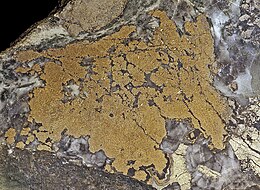| Nickeline | |
|---|---|
 | |
| General | |
| Category | Arsenide mineral |
| Formula (repeating unit) | nickel arsenide (NiAs) |
| IMA symbol | Nc[1] |
| Strunz classification | 2.CC.05 |
| Crystal system | Hexagonal |
| Crystal class | Dihexagonal dipyramidal (6/mmm) H-M symbol: (6/m 2/m 2/m) |
| Space group | P63/mmc |
| Unit cell | a = 3.602 Å, c = 5.009 Å; Z = 2 |
| Identification | |
| Color | Pale copper red with blackish tarnish. white with strong yellowish pink hue on polished section strongly anisotropic |
| Crystal habit | Massive columnar to reniform, rarely as distorted, horizontally striated, {1011} terminated crystals |
| Twinning | On {1011} producing fourlings |
| Cleavage | {1010} Imperfect, {0001} Imperfect |
| Fracture | Conchoidal |
| Tenacity | Brittle |
| Mohs scale hardness | 5 – 5.5 |
| Luster | metallic |
| Streak | brownish black |
| Diaphaneity | Opaque |
| Specific gravity | 7.8 |
| Pleochroism | Strong (reflected light) |
| Fusibility | 2 |
| Other characteristics | garlic odor on heating |
| References | [2][3][4] |
Nickeline or niccolite is the mineral form of nickel arsenide. The naturally-occurring mineral contains roughly 43.9% nickel and 56.1% arsenic by mass, but composition of the mineral may vary slightly.[2]
Small quantities of sulfur, iron and cobalt are usually present, and sometimes the arsenic is largely replaced by antimony. This last forms an isomorphous series with breithauptite (nickel antimonide).
- ^ Warr, L.N. (2021). "IMA–CNMNC approved mineral symbols". Mineralogical Magazine. 85 (3): 291–320. Bibcode:2021MinM...85..291W. doi:10.1180/mgm.2021.43. S2CID 235729616.
- ^ a b Anthony, John W.; Bideaux, Richard A.; Bladh, Kenneth W.; Nichols, Monte C. (2005). "Nickeline" (PDF). Handbook of Mineralogy. Mineral Data Publishing. Retrieved 13 August 2022.
- ^ Nickeline, Mindat.org, retrieved 13 August 2022
- ^ Barthelmy, David (2014). "Nickeline Mineral Data". Webmineral.com. Retrieved 13 August 2022.